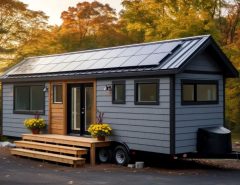My washing machine is one of these things that you pull out from a cupboard under the kitchen sink, and it’s got a drain pipe from the bottom going to the outside.
We’re building a new house (well, partially renovating an old one) and want to put washing machines in both houses under each of the sinks with pipes leading out to an existing oil tank. I know what I need to do but just can’t see how it would work!
Start your Washing machine drain plumbing
You need a trap between the washing machine and the tank. A good rule of thumb is to have at least 10mm of water in the trap.
If the washer has a pump, you will need an additional pump primer – this can be as simple as a ball cock valve open when full up/down – you can see an example in the diagram.

A new washing machine with a front loading door will be just like your old one (and I don’t think you can put it anywhere else that you’re thinking of). The only difference is the drain pipe comes out the back instead of under the sink.
Keep reading: How to restore an old trunk
The pipes from behind won’t matter because they won’t see any pressure from gravity anyway and will probably have a 45-degree trap into the open rising main somewhere close by.
The pump on these machines is normally built into them, so if you fit one, you’ll just be changing from a ball cock to pump primer.
I haven’t mentioned the other thing before about draining off the water at each end of the cycle. Don’t just assume it’s OK to leave the water in there because if you do, a very dirty gunk will eventually build up and block the overflow pipe from going down again.
The simplest thing is to have an outlet at either end of the trap about 30 mm above the bottom, so that when the waste pipe gets full wastewater fills into this pipe, then flows back into the big tank via these outlets instead of overflowing out onto your flooring. If you have new plumbing done, include these outlets as part of your order (they’re cheap). See how I’ve put them in below?
If you can see what I mean? As for drain pipes leading to an outside oil tank. Good luck with that one. I’m sure you need an “environmental permit” to do that, and I am pretty certain that would never happen, so just forget it and stick with your current scheme.
What plumbing is needed for a washing machine?
All plumbing for a washing machine depends on the type of washer that you choose. It is possible to connect your washing machine directly to the waste pipe, but this can be messy and cause problems if not properly installed. No matter what washer model you have, there will always be some water left in the tub after each cycle. The only way to ensure that there’s no residue left behind is by connecting it to an external drain system or sump well. All modern models come with a pump and are self-priming, making installation easier than ever before. Depending on where the new appliance will be placed, additional piping may need to be ordered separately as part of a kit or package deal.
If your washing machine has a pump, it is self-priming. You’ll notice that when you first turn the washer on, water will begin to fill the sump chamber. Once this occurs, the pump turns on and pumps water into your drains. If not installed properly, you may find yourself dealing with leaks or even wastewater backing up into your home’s pipes when you least expect it! The best way to prevent these problems is by installing a plumbing kit at the time of purchase.
The most basic kits
They are included all necessary parts necessary for draining off excess water within your sink area. In addition, to drain traps, kits also contain piping (often PVC) and adapters to direct any overflow water as needed. A simple but effective option is to place an overflow drain into your sink’s garbage disposal. Water that normally sits in the sump can now be sent directly down this drain and not onto your kitchen counters. Other kits also come with a pump primer so that the washer can pump water back up through any downstream piping and into your home’s main waste line. This ensures that no wastewater blocks your system from emptying properly.
Tags: Washing machine drain, Washing machine plumbing



